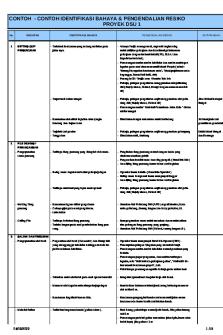Pre Plan NP1 Safety student with answers PDF

| Title | Pre Plan NP1 Safety student with answers |
|---|---|
| Course | Nursing Process I |
| Institution | Oklahoma City Community College |
| Pages | 2 |
| File Size | 76.7 KB |
| File Type | |
| Total Downloads | 96 |
| Total Views | 156 |
Summary
Clinical assignment...
Description
PRE-PLANNING ACTIVITY – NP1 This activity is designed to enhance your clinical knowledge and experience. Students are required to complete this pre planning clinical assignment focused on safe patient care and turn in to the clinical faculty at pre-conference. This assignment counts as two (2) hours of pre planning clinical hours as reported to the Oklahoma Board of Nursing (OBN). Failure to complete this assignment will result in a clinical absence and the student will not able to attend clinical. Please use your course textbooks as your primary source. Credible, scientific and professional websites and texts are also acceptable. Please list the references you utilized in the space provided at the end of the activity. Quality & Safety in Healthcare Watch the following video: Chasing Zero: Winning the War on Healthcare Harm
1. Give 3 examples from the video of processes that increased patient safety: 1. Smart pumps – double check for medications 2. Barcode technology – improve 5 rights of client 3. Share rounds – shift change rounding with on coming staff and client, including client in safety net.
2. Identify 5 practices that contributed to injury in the cases presented in the video: 1. Look alike medication labels - heparin vials 2. Missed Diagnosis – increased jaundice and labs 3. Misplaced Diagnostic information - Cancer 4. Breakdown in communication between healthcare team members and clients parents. 5. Medication preparation sign-off error in pharmacy – increased concentration error 3. Medication errors are some of the most common, and most dangerous, medical errors. Identify 5 recommended strategies recommended to decrease medication errors: 1. Standardizing the ordering, storage, preparation and administration of medications. 2. Improving access to information about medications - high alert meds 3. Limiting access to high-alert medications - extra steps 4. Using auxiliary labels and automated alerts 5. Employing redundancies
4. What are 10 high-alert medications/medication classes identified by the ISMP (Institute for Safe Medication Practices) – This information can be found on their website or in your texts: 1.adrenergic agents - epinephrine 2.adrenergic antagonist - propranolol 3.anesthetic agents - ketamine 4.antiarrhythemics - amiodarone 5.antithrombotic agents - warfarin 6.moderate sedation agents - lorazepam 7.sodium chloride for injection – hypertonic > 0.9% concentration 8.neuromuscular block agents - succinylcholine 9.sulfonylurea hypoglycemic - glipizide 10.insulin, subcutaneous and IV
5. What concerns do you have regarding patient safety as you being taking care of patients in the clinical setting?
My concern is an increased reliance on technology and the insidious errors this is creating in the healthcare setting. An example of this is in the body of the question we are asked to answer. Spell check overrode the intended word and could cause a misinterpretation of the intended meaning. I’ve seen this multiple times in my own practice with escribe scripts and have had to call for clarification many times. As I begin to provide care for my clients, I hope I am being observant of all safety parameters.
References: https://www.ismp.org/recommendations/high-alert-medications-acute-list
2...
Similar Free PDFs

Safety lesson plan
- 3 Pages

Student Example - Career Plan
- 9 Pages

Pharmacology Module NP1 SU20
- 3 Pages

Answers Student Book
- 44 Pages

Business plan pup marketing student
- 16 Pages
Popular Institutions
- Tinajero National High School - Annex
- Politeknik Caltex Riau
- Yokohama City University
- SGT University
- University of Al-Qadisiyah
- Divine Word College of Vigan
- Techniek College Rotterdam
- Universidade de Santiago
- Universiti Teknologi MARA Cawangan Johor Kampus Pasir Gudang
- Poltekkes Kemenkes Yogyakarta
- Baguio City National High School
- Colegio san marcos
- preparatoria uno
- Centro de Bachillerato Tecnológico Industrial y de Servicios No. 107
- Dalian Maritime University
- Quang Trung Secondary School
- Colegio Tecnológico en Informática
- Corporación Regional de Educación Superior
- Grupo CEDVA
- Dar Al Uloom University
- Centro de Estudios Preuniversitarios de la Universidad Nacional de Ingeniería
- 上智大学
- Aakash International School, Nuna Majara
- San Felipe Neri Catholic School
- Kang Chiao International School - New Taipei City
- Misamis Occidental National High School
- Institución Educativa Escuela Normal Juan Ladrilleros
- Kolehiyo ng Pantukan
- Batanes State College
- Instituto Continental
- Sekolah Menengah Kejuruan Kesehatan Kaltara (Tarakan)
- Colegio de La Inmaculada Concepcion - Cebu










